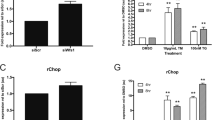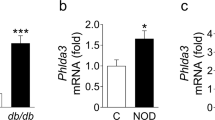Abstract
Trafficking of pancreatic KATP channels to the plasma membrane critically depends on masking the endoplasmic reticulum (ER) retention signals of the SUR1 and Kir6.2 subunits upon their proper assembly into functional hetero-octamers. When expressed in the absence of the partner protein, each subunit might accumulate in the ER and trigger β-cell ER stress and oxidative stress. To test this hypothesis, Kir6.2 localisation, ER ultra-structure and ER-stress- and oxidative-stress-response gene mRNA levels were evaluated in pancreatic endocrine cells from adult wild-type (WT) and Sur1 knockout (Sur1 -/-) mice. As previously reported, Kir6.2 was mainly expressed on secretory granules and at the plasma membrane of WT islet cells. In contrast, like the ER chaperone calreticulin, Kir6.2 was primarily localised in the rough endoplasmic reticulum (RER) of Sur1 -/- islet cells. ER retention of Kir6.2 was demonstrated (electron microscopy) by a significant increase in the length and Kir6.2 density of RER in Sur1 -/- vs WT islet cells. Despite Kir6.2 retention in RER, Xbp1 mRNA splicing and mRNA levels of preproinsulin and ER-stress-response genes Bip, Edem and Gadd153 were similar in WT and Sur1 -/- islets. However, mRNA levels of the antioxidant enzymes Sod1, Sod2, Gpx2 and catalase were significantly up-regulated in Sur1 -/- islets. Sequestration of Kir6.2 in RER of Sur1 -/- islet cells is thus associated with an increase in RER length and mild oxidative stress without activation of the classical ER stress response.







Similar content being viewed by others
Abbreviations
- BiP:
-
Immunoglobulin heavy chain binding protein
- CHI:
-
Congenital hyperinsulinism of infancy
- Cyp1a1:
-
Cytochrome P450, family 1, subfamily a, polypeptide 1
- Edem:
-
Endoplasmic reticulum degradation-enhancer mannosidase alpha-like 1
- Fmo1:
-
Flavin monooxygenase 1
- Gadd:
-
Growth arrest and DNA damage
- Gpx2:
-
Glutathione peroxidase 2
- GSIS:
-
Glucose stimulation of insulin secretion
- KATP :
-
ATP-sensitive potassium channel
- RER:
-
Rough endoplasmic reticulum
- ROS:
-
Reactive oxygen species
- Sod1:
-
Superoxide dismutase 1, soluble
- Sod2:
-
Superoxide dismutase 2, mitochondrial
- SUR1:
-
Sulphonylurea receptor 1
- Sur1 -/- :
-
Sur1 knockout
- Tbp:
-
TATA-box binding protein
- WT:
-
Wild-type
- Xbp1:
-
X-box binding protein 1
References
Afonso V, Champy R, Mitrovic D, Collin P, Lomri A (2007) Reactive oxygen species and superoxide dismutases: role in joint diseases. Joint Bone Spine 74:324–329
Aguilar-Bryan L, Bryan J (1999) Molecular biology of adenosine trisphosphate-sensitive potassium channels. Endocr Rev 20:101–135
Aguilar-Bryan L, Clement JP 4th, Gonzalez G, Kunjilwar K, Babenko A, Bryan J (1998) Toward understanding the assembly and structure of KATP channels. Physiol Rev 78:227–245
Ali BR (2009) Is cystic fibrosis-related diabetes an apoptotic consequence of ER stress in pancreatic cells? Med Hypotheses 72:55–57
Ashcroft FM, Gribble FM (1999) ATP-sensitive K+ channels and insulin secretion: their role in health and disease. Diabetologia 42:903–919
Aynsley-Green A, Bloom PJM, SR GMH, Keeling J, Ashcroft SJH, Turner RC, Baum JD (1981) Nesidioblastosis of the pancreas: definition of the syndrome and the management of the severe neonatal hyperinsulinemic hypoglycemia. Am J Dis Child 56:496–508
Cartier EA, Conti LR, Vandenberg CA, Shyng SL (2001) Defective trafficking and function of KATP channels caused by a sulfonylurea receptor 1 mutation associated with persistent hyperinsulinemic hypoglycemia of infancy. Proc Natl Acad Sci USA 98:2882–2887
Clement JP 4th, Kunjilwar K, Gonzalez G, Schwanstecher M, Panten U, Aguilar-Bryan L, Bryan J (1997) Association and stoichiometry of KATP channel subunits. Neuron 18:827–838
Dunne MJ, Cosgrove KE, Shepherd RM, Aynsley-Green A, Lindley KJ (2004) Hyperinsulinism in infancy: from basic science to clinical disease. Physiol Rev 84:239–275
Elouil H, Bensellam M, Guiot Y, Vander Mierde D, Pascal SM, Schuit FC, Jonas JC (2007) Acute nutrient regulation of the unfolded protein response and integrated stress response in cultured rat pancreatic islets. Diabetologia 50:1442–1452
Flagg TP, Remedi MS, Masia R, Gomes J, McLerie M, Loptain AN, Nichols CG (2005) Transgenic overexpression of SUR1 in the heart suppresses sarcolemmal K(ATP). J Mol Cell Cardiol 39:647–656
Flanagan SE, Patch AM, Mackay DJ, Edghill EL, Gloyn AL, Robinson D, Shield JP, Temple K, Ellard S, Hattersley AT (2007) Mutations in ATP-sensitive K+ channel genes cause transient neonatal diabetes and permanent diabetes in childhood or adulthood. Diabetes 56:1930–1937
Flanagan SE, Clauin S, Bellanné-Chantelot C, Lonlay P de, Harries LW, Gloyn AL, Ellard S (2009) Update of mutations in the genes encoding the pancreatic beta-cell K(ATP) channel subunits Kir6.2 (KCNJ11) and sulfonylurea receptor 1 (ABCC8) in diabetes mellitus and hyperinsulinism. Hum Mutat 30:170–180
Glaser B, Ryan F, Donath M, Landau H, Stanley CA, Baker L, Barton DE, Thornton PS (1999) Hyperinsulinism caused by paternal-specific inheritance of a recessive mutation in the sulfonylurea-receptor gene. Diabetes 48:1652–1657
Gloyn AL, Reimann F, Girard C, Edghill EL, Proks P, Pearson ER, Temple IK, Mackay DJ, Shield JP, Freedenberg D, Noyes K, Ellard S, Ashcroft FM, Gribble FM, Hattersley AT (2005) Relapsing diabetes can result from moderately activating mutations in KCNJ11. Hum Mol Genet 14:925–934
Guiot Y, Stevens M, Marhfour I, Stiernet P, Mikhailov M, Ashcroft SJH, Rahier J, Henquin JC, Sempoux C (2007) Morphological localization of sulfonylurea receptor 1 in endocrine cells of human, mouse and rat pancreas. Diabetologia 50:1889–1899
Harding HP, Zeng H, Zhang Y, Jungries R, Chung P, Plesken H, Sabatini DD, Ron D (2001) Diabetes mellitus and exocrine pancreatic dysfunction in perk-/- mice reveals a role for translational control in secretory cell survival. Mol Cell 7:1153–1163
Inagaki N, Gonoi T, Clement JP 4th, Namba N, Inazawa J, Gonzalez G, Aguilar-Bryan L, Seino S, Bryan J (1995) Reconstitution of IKATP: an inward rectifier subunit plus the sulfonylurea receptor. Science 270:1166–1170
Jonas JC, Guiot Y, Rahier J, Henquin JC (2003) Haeme-oxygenase 1 expression in rat pancreatic beta cells is stimulated by supraphysiological glucose concentrations and by cyclic AMP. Diabetologia 46:1234–1244
Koster JC, Marchall BA, Ensor N, Corbett JA, Nichols CG (2000) Target overactivity of β cell KATP channels induces profound neonatal diabetes. Cell 100:645–654
Lacraz G, Figeac F, Movassat J, Kassis N, Coulaud J, Galinier A, Leloup C, Bailbé D, Homo-Delarche F, Portha B (2009) Diabetic beta-cells can achieve self-protection against oxidative stress through an adaptive up-regulation of their antioxidant defenses. PLoS ONE 4:e6500
Livak KJ, Schmittgen TD (2001) Analysis of relative gene expression data using real-time quantitative PCR and the 2 -ΔΔCT method. Methods 25:402–408
Makhina EN, Nichols CG (1998) Independent trafficking of KATP channel subunits to the plasma membrane. J Biol Chem 273:3369–3374
Marhfour I, Moulin P, Marchandise J, Rahier J, Sempoux C, Guiot Y (2009) Impact of Sur1 gene inactivation on the morphology of mouse pancreatic endocrine tissue. Cell Tissue Res 335:505–515
Marthinet E, Bloc A, Oka Y, Tanizawa Y, Wehrle-Haller B, Bancila V, Dubuis JM, Philippe J, Schwitzgebel VM (2005) Severe congenital hyperinsulinism caused by a mutation in the Kir6.2 subunit of the adenosine triphosphate-sensitive potassium channel impairing trafficking and function. J Clin Endocrinol Metab 90:5401–5406
Miki T, Tashiro F, Iwanaga T, Nagashima K, Yoshitomi H, Aihara H, Nitta Y, Gonoi T, Inagaki N, Miyazaki J, Seino S (1997) Abnormalities of pancreatic islets by targeted expression of a dominant-negative KATP channel. Proc Natl Acad Sci USA 94:11969–11973
Miki T, Nagashima K, Tashiro F, Kotake K, Yoshitomi H, Tamamoto A, Gonoi T, Iwanaga T, Miyazaki J, Seino S (1998) Defective insulin secretion and enhanced insulin action in KATP channel-deficient mice. Proc Natl Acad Sci USA 95:10402–10406
Morel Y, Barouki R (1999) Repression of gene expression by oxidative stress. Biochem J 342:481–496
Nenquin M, Szollosi A, Aguillar-Bryan L, Bryan J, Henquin JC (2004) Both triggering and amplifying pathways contribute to fuel-induced insulin secretion in the absence of sulfonylurea receptor-1 in pancreatic beta-cells. J Biol Chem 279:32316–32324
Nichols CG, Koster JC, Remedi MS (2007) Beta-cell hyperexcitability: from hyperinsulinism to diabetes. Diabetes Obes Metab 9 (Suppl 2):81–88
Oyadomari S, Koizumi A, Takeda K, Gotoh T, Akira S, Araki E, Mori M (2002) Targeted disruption of the Chop gene delays endoplasmic reticulum stress-mediated diabetes. J Clin Invest 109:525–532
Philimonenko A, Janacek J, Hozak P (2000) Statistical evaluation of colocalization patterns in immunogold labelling experiments. J Struct Biol 132:201–210
Rahier J, Fält K, Müntefering H, Becker K, Gepts W, Falkmer S (1984) The basic structural lesion of persistent neonatal hypoglycaemia with hyperinsulinism: deficiency of pancreatic D cells or hyperactivity of B cells? Diabetologia 26:282–289
Rahier J, Guiot Y, Sempoux C (2000) Persistent hyperinsulinaemic hypoglycaemia of infancy: a heterogeneous syndrome unrelated to nesidioblastosis. Arch Dis Child Fetal Neonatal Ed 82:F108–F112
Scheuner D, Kaufman RJ (2008) The unfolded protein response: a pathway that links insulin demand with β-cell failure and diabetes. Endocr Rev 29:317–333
Seghers V, Nakazaki M, DeMayo F, Aguillar-Bryan L, Bryan J (2000) Sur1 knockout mice: a model for KATP channel-independent regulation of insulin secretion. J Biol Chem 275:9270–9277
Sempoux C, Guiot Y, Lefèvre A, Nihoul-Fékété C, Jaubert F, Saudubray JM, Rahier J (1998) Neonatal hyperinsulinaemic hypoglycaemia: heterogeneity of the syndrome and keys for differential diagnosis. J Clin Endocrinol Metab 83:1455–1461
Sempoux C, Guiot Y, Dahan K, Moulin P, Stevens M, Lambot V, Lonlay P de, Fournet JC, Junien C, Jaubert F, Nihoul-Fekete C, Saudubray JM, Rahier J (2003) The focal form of persistent hyperinsulinaemic hypoglycaemia of infancy: morphological and molecular studies show structural and functional differences with insulinoma. Diabetes 52:784–794
Sharma N, Crane A, Clement JP 4th, Gonzalez G, Babenko AP, Bryan J, Aguilar-Bryan L (1999) The C terminus of SUR1 is required for trafficking of KATP channels. J Biol Chem 274:20628–20632
Szollosi A, Nenquin M, Henquin JC (2007) Overnight culture unmasks glucose-induced insulin secretion in mouse islets lacking ATP-sensitive K+ channels by improving the triggering Ca2+ signal. J Biol Chem 282:14768–14776
Taschenberger G, Mougey A, Shen S, Lester LB, LaFranchi S, Shyng SL (2002) Identification of a familial hyperinsulinism-causing mutation in the sulfonylurea receptor 1 that prevents normal trafficking and function of KATP channels. J Biol Chem 277:17139–17146
Teckman JH, Perlmutter DH (2000) Retention of mutant alpha(1)-antitrypsin Z in endoplasmic reticulum is associated with an autophagic response. Am J Physiol Gastrointest Liver Physiol 279:G961–G974
Thomas PM, Cote GJ, Wohllk N, Haddad B, Mathew PM, Rabl W, Aguilar-Bryan L, Gagel RF, Bryan J (1995) Mutations in the sulfonylurea receptor gene in familial persistent hyperinsulinemic hypoglycemia of infancy. Science 268:426–429
Thomas PM, Ye Y, Lightner E (1996) Mutation of the pancreatic islet inward rectifier Kir6.2 also leads to familial persistent hyperinsulinemic hypoglycemia of infancy. Hum Mol Genet 5:1809–1812
Yan F, Lin CW, Weisiger E, Cartier EA, Taschenberger G, Shyng SL (2004) Sulfonylureas correct trafficking defects of ATP-sensitive potassium channels caused by mutations in the sulfonylurea receptor. J Biol Chem 279:11096–11105
Zerangue N, Schwappach B, Jan LY (1999) A new ER trafficking signal regulates the subunit stoichiometry of plasma membrane KATP channels. Neuron 22:537–548
Acknowledgments
We thank J. Bryan (Pacific Northwest Diabetes Research Institute, Seattle, Washington, USA) and J.C. Henquin (Unit of Endocrinology and Metabolism, Faculty of Medicine, Université Catholique de Louvain, Brussels, Belgium) for providing the Sur1 -/- mice. We also thank S.L. Shyng (University of California, USA) for the gift of the Kir6.2 antibody and S. Lagasse for expert technical assistance.
Author information
Authors and Affiliations
Corresponding author
Additional information
This work was supported by grants 3.4616.05 (J. Rahier), 9.4559.04 (C. Sempoux) and 3.4.516.09 (J.C. Jonas; senior associate of FNRS) from the Fonds de la Recherche Scientifique Médicale, FNRS, Belgium) and by an ARC grant 05/10—328 (I.M., C.S. and J.C.J.) from the General Direction of Scientific Research of the French Community of Belgium.
Rights and permissions
About this article
Cite this article
Marhfour, I., Jonas, JC., Marchandise, J. et al. Endoplasmic reticulum accumulation of Kir6.2 without activation of ER stress response in islet cells from adult Sur1 knockout mice. Cell Tissue Res 340, 335–346 (2010). https://doi.org/10.1007/s00441-010-0958-8
Received:
Accepted:
Published:
Issue Date:
DOI: https://doi.org/10.1007/s00441-010-0958-8




